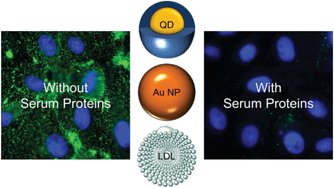Cellular binding of anionic nanoparticles is inhibited by serum proteins independent of nanoparticle composition†
Abstract

* Corresponding authors
a
School of Chemistry and Biochemistry and Petit Institute for Bioengineering and Bioscience, Georgia Institute of Technology, 901 Atlantic Drive, Atlanta, GA, USA
E-mail:
christine.payne@chemistry.gatech.edu
Fax: +1 404-385-6057
Tel: +1 404-385-3125

 Please wait while we load your content...
Something went wrong. Try again?
Please wait while we load your content...
Something went wrong. Try again?
C. C. Fleischer, U. Kumar and C. K. Payne, Biomater. Sci., 2013, 1, 975 DOI: 10.1039/C3BM60121H
To request permission to reproduce material from this article, please go to the Copyright Clearance Center request page.
If you are an author contributing to an RSC publication, you do not need to request permission provided correct acknowledgement is given.
If you are the author of this article, you do not need to request permission to reproduce figures and diagrams provided correct acknowledgement is given. If you want to reproduce the whole article in a third-party publication (excluding your thesis/dissertation for which permission is not required) please go to the Copyright Clearance Center request page.
Read more about how to correctly acknowledge RSC content.
 Fetching data from CrossRef.
Fetching data from CrossRef.
This may take some time to load.
Loading related content
